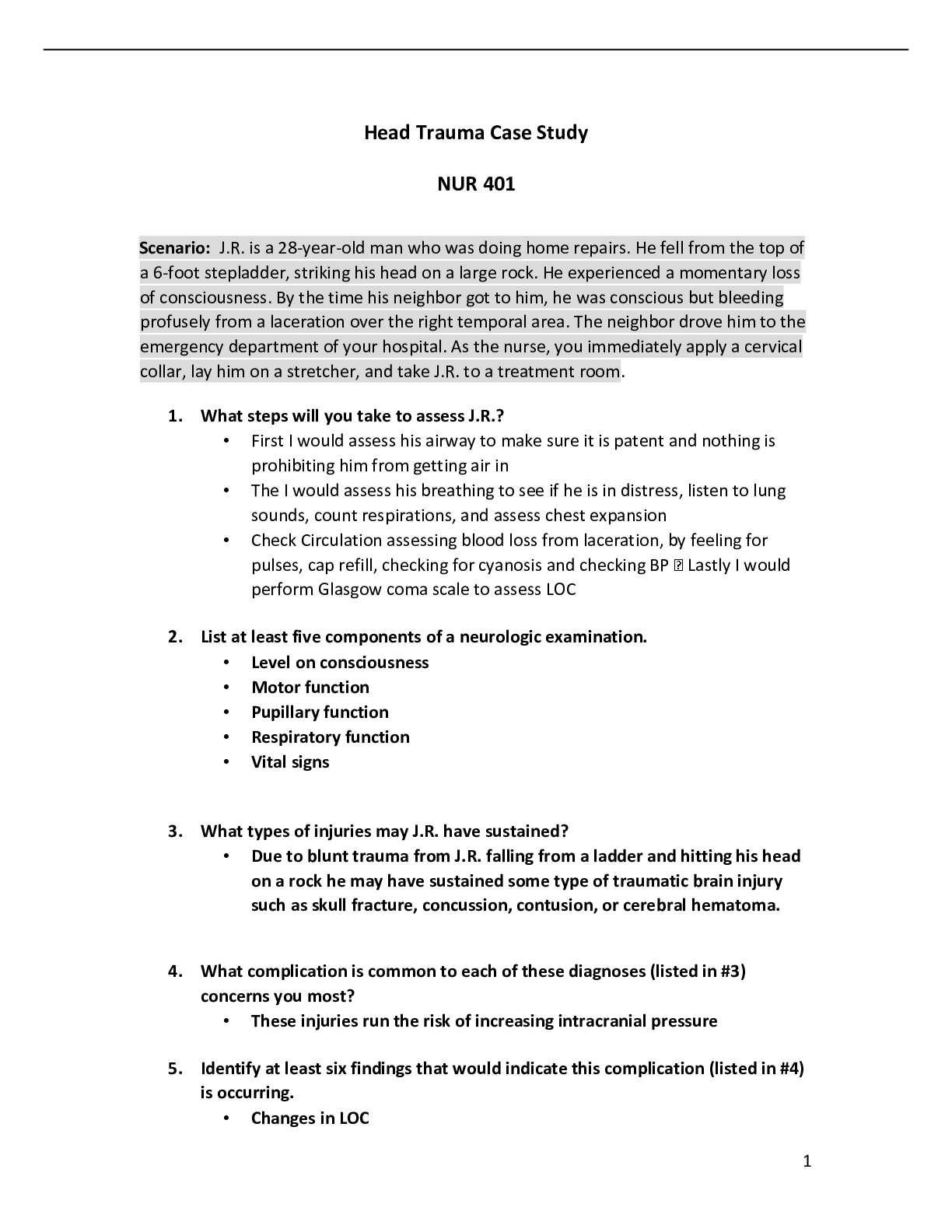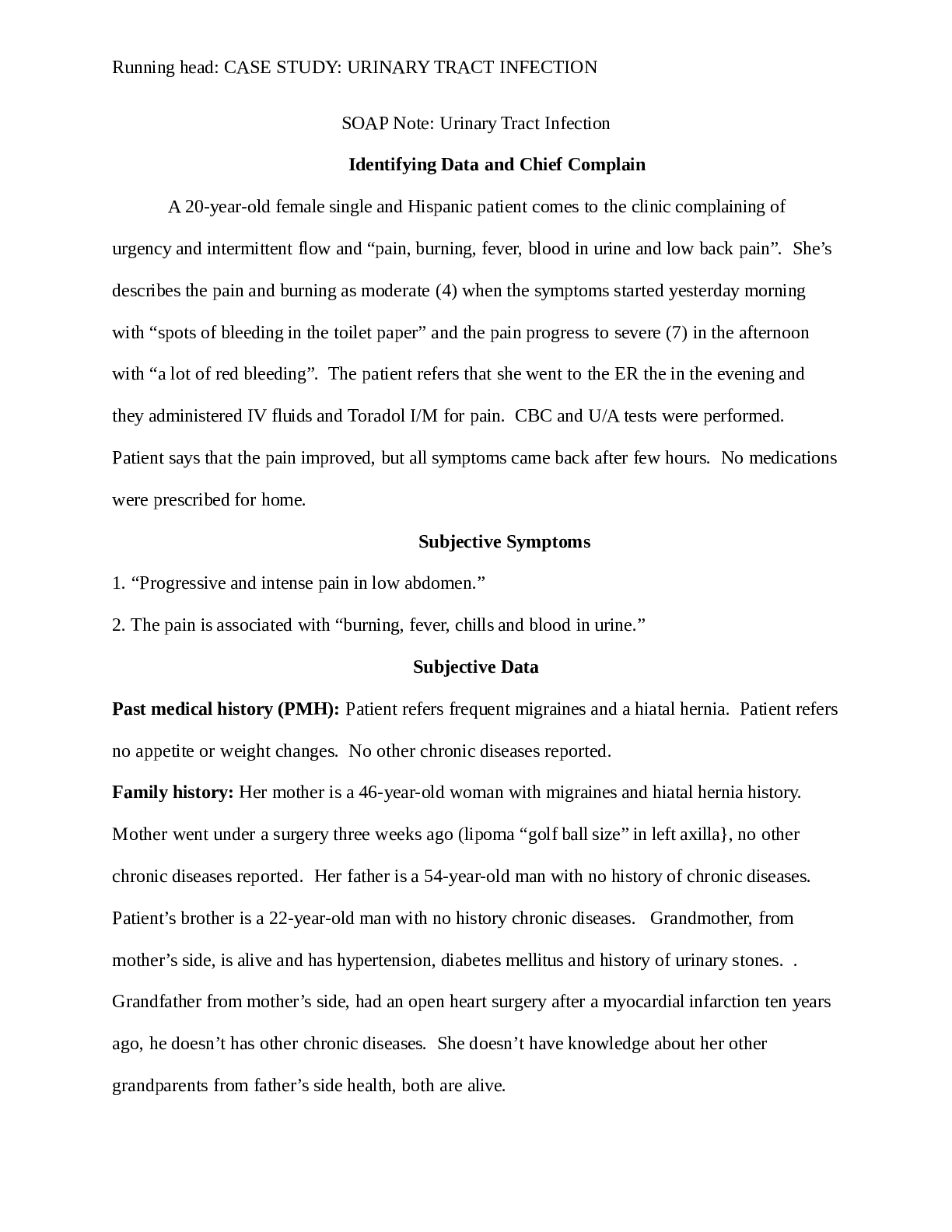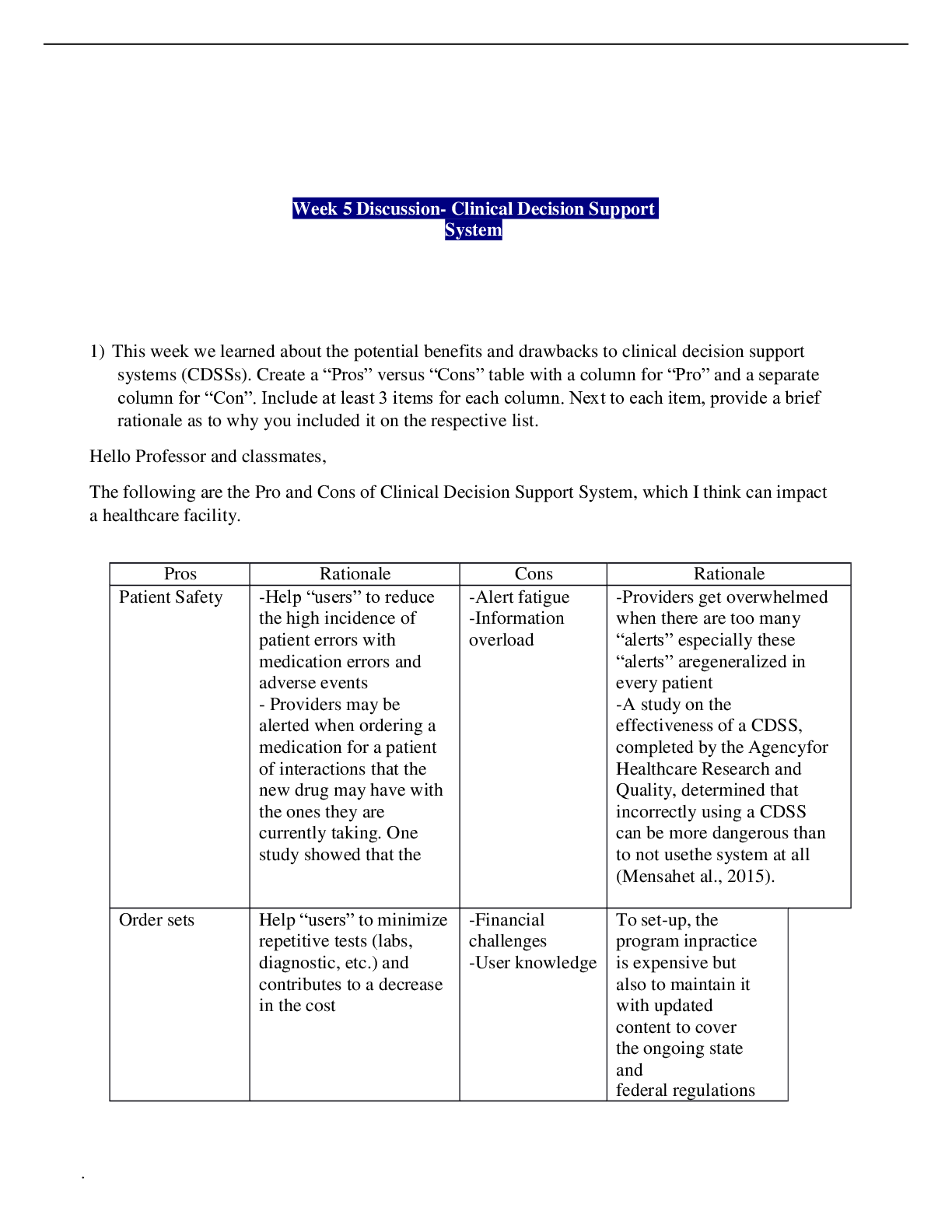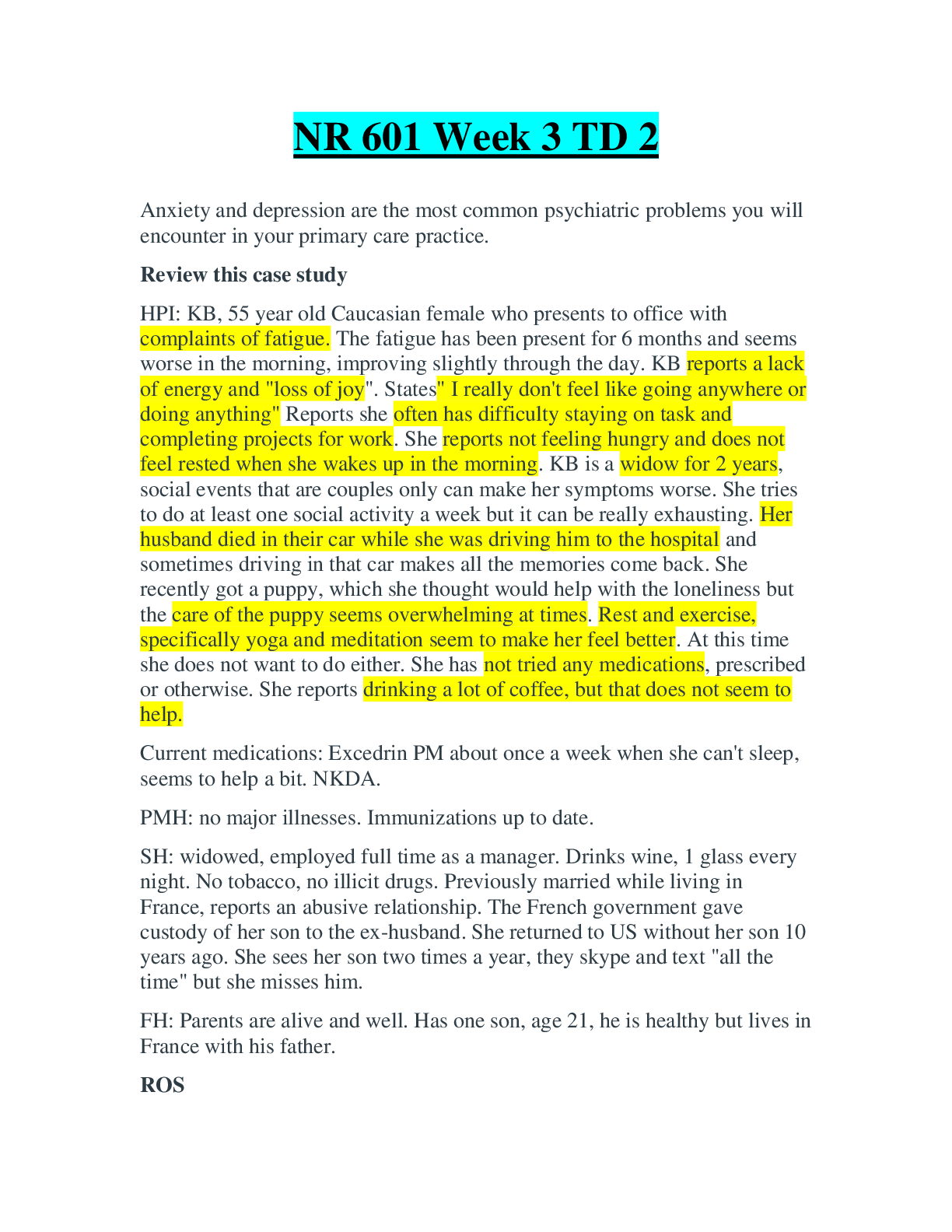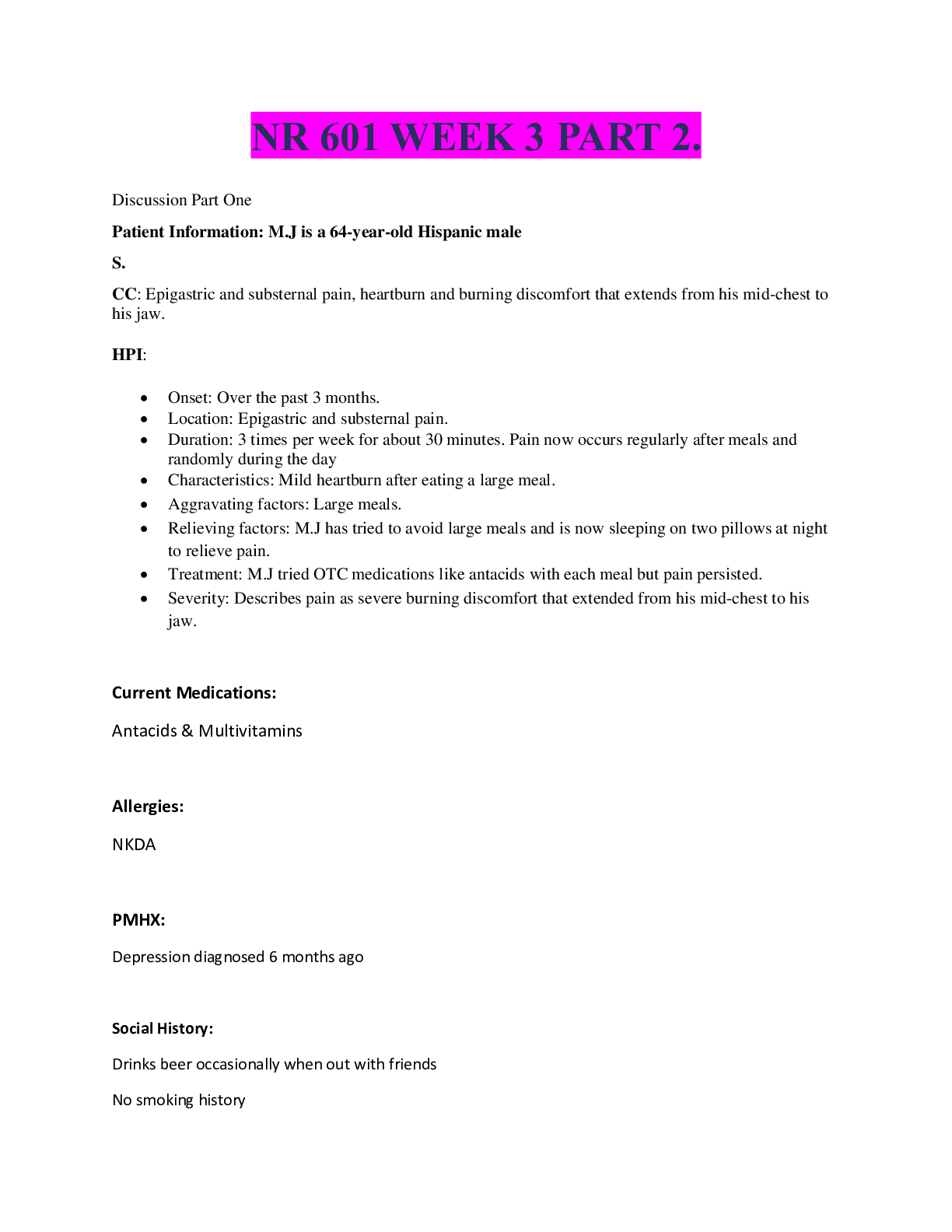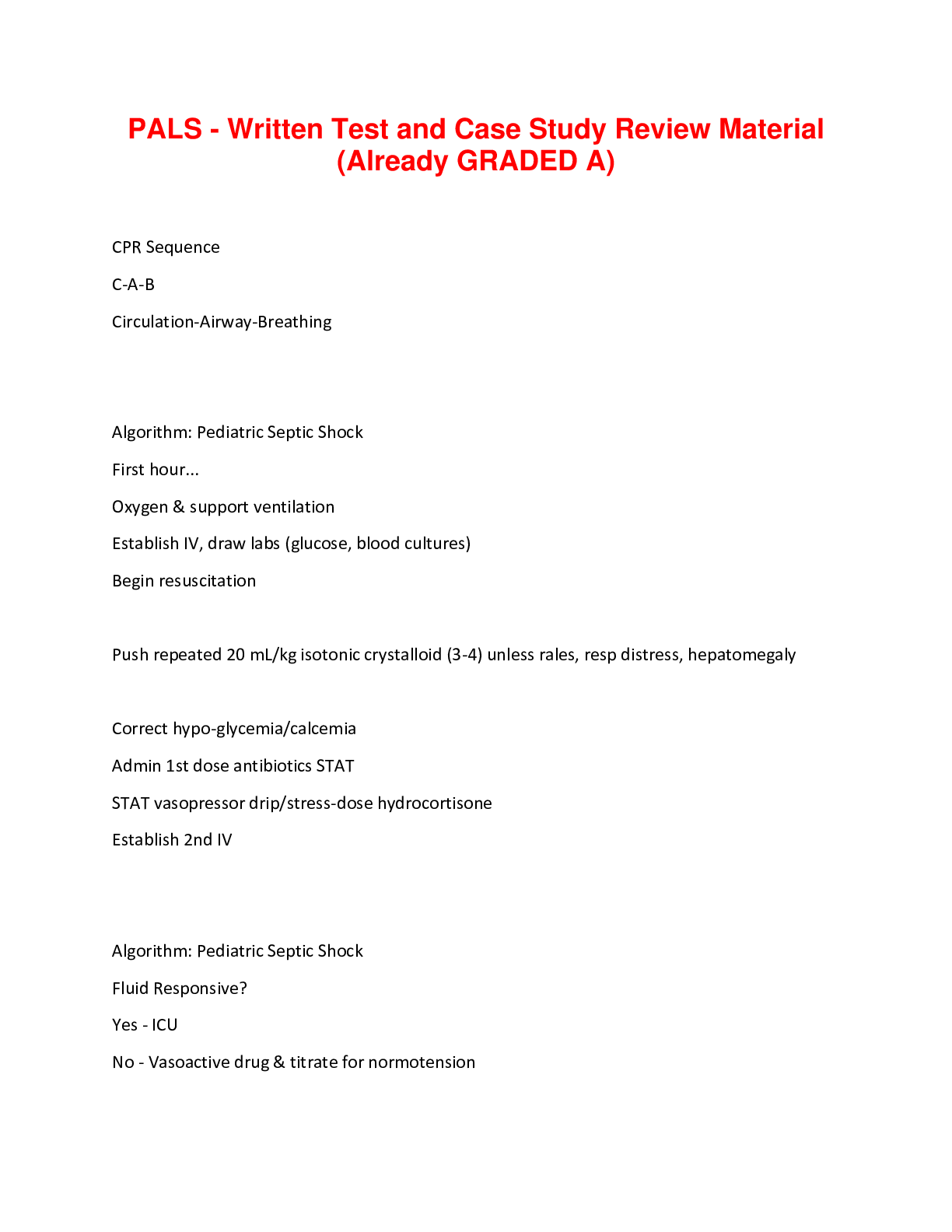*NURSING > CASE STUDY > GH4001: Principles of Epidemiology case studies (answered) / NURS 4115 case study scenarios(answered (All)
GH4001: Principles of Epidemiology case studies (answered) / NURS 4115 case study scenarios(answered) latest Spring 2021 ( already graded A)
Document Content and Description Below
Scenario: Sam, a 35-year old, married mother of two, is an elementary school teacher at a private school in a suburban area. She recently complained of chest pains and an incessant cough, which result... ed in her coughing up blood earlier today. Concerned, she has just entered the emergency room department at the city hospital. Diego is the ER nurse who processed Sam's intake and took a sputum culture to be tested. Laboratory results confirm infection with tuberculosis. Concerned about Sam's positive test result, Diego decided to re-interview Sam and determined that she recently returned from a mission trip to poverty stricken areas of Buenos Aires, Argentina. 1. Based on this scenario, use the epidemiological triangle, the web of causality, and/or the ecological model to examine Sam's infection with TB. Include in your response the elements of the epidemiological triangle (host, agent, and environment) 2. Explain the significance of the "shrinking world" and how it may impact the field of epidemiology. Be sure to include global health data to support your explanation. Scenario: You are a public health nurse who is interested in obtaining data related to a health behavior problem that you see in your nursing practice. You would like to research this health problem or behavior and access health data that might be available to help inform your nursing practice. NOTE: For this Assessment, you are to identify a health problem or behavior and not an infectious disease or specific diagnosis (Some examples of health problems or behaviors: smoking, obesity, substance abuse, teen pregnancy, or mental illness). 1. Identify two sources of data that you might access to research your health problem or behavior in your community. Then, explain why you would use these two sources of data, including the type of data you are likely to find with each source. 2. Explain the incidence and prevalence of the health problem or behavior in your community that you selected based on the sources of data you identified. 3. Describe the levels of prevention as they relate to nursing practice for the health problem or behavior you selected in your community. 4. Explain what it means to "think upstream." Then, explain how you might integrate upstream thinking into your nursing practice to address the health problem or behavior you selected in your community. 5. Explain how the determinants of health help contribute to patient advocacy by nurses and healthcare professionals in relation to the health problem or behavior selected and in relation to your community. PART I: FILL IN THE BLANKS 1._____ is one of the primary causes of maternal mortality associated with childbearing that may be due to a small section of retained placenta. 2.The incomplete return of the uterus to its prepregnant size and shape is referred to as _____. 3.To confirm urinary retention, a catheterized amount of _____ is measured. 4.Postpartum _____ is a normal accompaniment to birth. 5.The 2020 National Health Goals include seeing an increase to at least _____% of the infants being breastfed. 6.Infants born with severe developmental hip dysplasia may be placed in a _____ to try to correct the problem. 7._____ occurs when the sternocleidomastoid is injured and bleeds during birth. 8.Infants with a meconium ileus should be screened for _____ _____. 9._____ is the accumulation of cerebrospinal fluid in the ventricles or subarachnoid space. 10.Simple spina bifida occulta is a(n) _____ disorder. PART II: TRUE OR FALSE 1.When establishing expected outcomes for newborns, the outcomes should be consistent with the newborn's potential. 2.It is estimated that between 10% and 15% of newborns require some assistance to begin breathing. 3.Newborns should be kept in a neutral-temperature environment. 4.Every infant experiences respiratory acidosis until he or she takes a first breath. 5.The best "milk" for preterm infants is a commercial formula that best suits their individual situation PART III: SITUATIONAL ANALYSIS (3). You are preparing the discharge care plan for a patient who delivered a healthy son 24 hours earlier. The patient and infant have been doing well with no complications; however, when you enter the room, you notice the patient is diaphoretic and flushed. She is trying to fan herself. Her vital signs reveal a temperature of 100.6°F, heart rate of 90 beats/min, respiratory rate of 24 breaths/min, and blood pressure of 130/88 mmHg. A. What assessments will you do? B. What interventions will you implement? C. What are your expected outcomes? (4).The patient is a 20-year-old G1P0 who shows up in the emergency department in active labor. She has a strong odor of alcohol on her breath and her blood-alcohol level measures 1.2. She is evasive about prenatal care but finally admits she has not received any. She also cannot remember the date of her last menstruation period A. What are the immediate concerns for this mother and infant? B. What potential complications should the nursing staff prepare for C.What nursing diagnoses would be appropriate in this situation? (5). You are assessing an infant who was born with a cleft palate. The parents are concerned and want it corrected immediately before taking their baby home A. What teaching is necessary before the child and parents go home? B. What therapies and/or corrections should the nurse teach the parents? C. What nursing diagnoses are appropriate in this case? PART IV: FILL IN THE BLANKS 1.Children with an IQ between 20 and 34 are considered to experience _____ cognitive challenge. 2. _____ is a learning disorder where the individual reads in reverse. 3. _____ is an eating disorder where the individual persists in eating non-food items. 4. _____ syndrome is an inherited syndrome of motor and phonic vocal tics. 5. _____ or the involuntary loss of feces is more common in boys than girls. 6. Burns from maltreatment are often on the _____ surface of the body. 7. _____ maltreatment includes constant belittling or threatening, rejecting, isolating, or exploiting a child. 8. Failure to thrive is a unique syndrome in which an infant falls below the _____ percentile for weight and height on a standard growth chart. 9. _____ is sexual activity between family members. 10. A cycle of violence often follows three phases: tension-building, _____ _____, and a "honeymoon" phase. 11. Most children with a long-term illness receive most of their health care at _____. 12. A parent's usual response to the diagnosis of a terminal illness in a child is _____. 13. Nurses who enter the _____ phase of grief may become ineffective caregivers. 14. The second stage of grief is _____. 15. Throughout the stages of grieving, parents develop important _____ mechanisms to help them through this crisis. PART V: SITUATIONAL ANALYSIS (7) "You can't be talking about our son!" The heartbroken parents cried. "But he was doing so well and learning and growing. Why has this happened?" The physician has just told the parents their son has developed an autism spectrum disorder. a. What nursing care will you plan for this family? b. What are some nursing diagnoses for this situation (more than 1 please) c. What are some expected outcomes? (8) A mother comes into the emergency department with her 18-month-old son screaming because he has been burned. When questioned, the mother states, "He jumped into the bathtub I was fixing for myself. I guess the water was too hot." However, the exam shows second and third-degree burns on the dorsal side of the legs and feet, abdomen, hands, and distal arms. a .How would you as the nurse, respond? b. You suspect this child had hot water thrown on him. How would you proceed? c. Identify some nursing diagnoses for this situation. (9) The health care provider has informed the family that regrettably, there is nothing else that they can do for cancer that is affecting the youngest. The 7-year-old is accepting the news better than anyone else. Arrangements are being made for hospice to help care for the child and assist the family. a. What concerns do you think you should address? b. What patient-centered care would you implement? c. What information will the family need at this time? Scenario: C.S. is a 78-year-old PT admitted to the nursing home unit with a diagnosis of dehydration. C.S. has increased her fluid intake as suggested, but now needs to use the restroom. Please answer the following questions: 1. What safety assessments should be completed on the patient prior to assisting with ambulation to the restroom? 2. What Risk factors does the patient have for falls? 3. List 2 interventions and provide rationales on how to prevent falls for C.S. After doing the safety assessment of the patient, C.S. is escorted to the restroom by the nurse. Although safety protocols were in place, C.S. slipped on a small amount of urine that was previously left on the bathroom floor. The nurse immediately recognizes that a safety event has just occurred. Please answer the following questions: 1. What are priority assessments of this patient? 2. If the patient is safe to move, what safety equipment can be utilized? C.S. is back in bed and comfortable. A little shaken up from the fall, but there are no physical injuries noted. The nurse knows that this would be a good time to complete documentation of the event. A. Formulate a NOTE to include in the patients' electronic medical record: B. What should be documented in the Safety Event Report for this patient? Scenario: A nurse is preparing to administer medications to a client for whom the nurse has the following data: Diagnosis Major depressive disorder Vital signs • BP 152/78 mm Hg • Pulse rate 92/min • Respiratory rate 18/min • Oral temperature 36.7° C (98.1° F) • O2 saturation 97% on room air • Weight 97.7 kg (215 lb) Allergies Gentamicin Medical history • Panic disorder • Fibromyalgia • Posttraumatic stress disorder • Congestive heart failure • Hypertension Laboratory Test Results • Potassium 3.7 mEq/L • Sodium 146 mEq/L • BUN 18 mg/dL • Hgb 15 g/dL • Hct 54% • ECG: normal sinus rhythm Diet Low-sodium Scheduled Procedures Electroconvulsive therapy (ECT) in 1 hr Medications to Administer Diazepam 5 mg oral twice daily Gabapentin 300 mg oral three times daily Atropine 0.4 mg IM 1 dose 30 min preprocedure Lisinopril 20 mg oral once daily Furosemide 40 mg oral once daily Succinylcholine 0.6 mg/kg IV during procedure Which three medications require clarification prior to administration? (Complete the following sentences by choosing from the dropdown lists. Do not use the same medication selection more than once.) Questions: The nurse should clarify the prescription for Select an option diazepam gabapentin atropine lisinopril furosemide succinylcholine because Select an option 1-the client is scheduled for ECT. 2-administering the medication is outside the nurse's scope of practice. 3-of the client's blood pressure. 4-of the client's allergy. 5-the client has a history of congestive heart failure. 6-of the client's sodium level. The nurse should clarify the prescription for Select a medication option diazepam gabapentin atropine lisinopril furosemide succinylcholine because Select an option 1- the client is scheduled for ECT. 2-administering the medication is outside the nurse's scope of practice. 3-of the client's blood pressure. 4-of the client's allergy. 5-the client has a history of congestive heart failure. 6-of the client's sodium level. The nurse should clarify the prescription for Select a medication option diazepam gabapentin atropine lisinopril furosemide succinylcholine BECAUSE Select an option 1-the client is scheduled for ECT. 2-administering the medication is outside the nurse's scope of practice. 3-of the client's blood pressure. 4-of the client's allergy. 5-the client has a history of congestive heart failure. 6-of the client's sodium level. Scenario: A 44 year old male patient has been admitted to the medical surgical unit of the hospital for after seeking treatment for nausea vomiting, and severe abdominal pain. The patient developed sudden and intense pain in the right upper quadrant the evening before and waited for a few hours before seeking treatment. He has a history of substance abuse and has been in rehabilitation for both alcohol and stimulant abuse. He currently still uses both alcohol and methamphetamines, despite previous attempts of treatment at detoxification centers. Upon admission, the patient is anxious and restless, complaining of severe pain that is unrelieved by pain medication. The nurse contacts the physician to ask for further orders for opioid medications to treat the pain. The physician also orders further diagnostic tests to confirm the cause of the patient's pain and symptoms, as well as a 500 mL bolus of lactated Ringer's solution IV, followed by a regular rate of LR at 150mL/hr. 1. What type of diagnostic tests would most likely be ordered that could determine the cause of this type of abdominal pain? 2. What laboratory tests would the physician most likely order? 3. What effects would the patient's history of drug and alcohol abuse have on his abdominal pain? The physician orders an abdominal ultrasound and several laboratory tests, including a CBC, metabolic panel, glucose, serum amylase, and serum lipase. The nurse is also given an order for IV fentanyl to be given prn every 4 hours for pain control. After undergoing the ultrasound, the physician considers that the patient may have acute pancreatitis cause by inflammation; there are several lesions noted on the pancreas that may have been caused by chronic alcohol abuse. 4. Based on the diagnosis of acute pancreatitis, what changes in laboratory values would the nurse expect to see in this patient? 5. Why is pain control such an important component of management of acute pancreatitis? Following diagnosis and continued administration of pain medications, the patient is still complaining of pain. The nurse notes several areas of petechiae on his abdomen, particularly in the right upper quadrant. While once complaining vocally about the pain, the patient now is more quiet, lethargic, grimacing, and guarding the abdomen. His vital signs are: HR: 102 bpm, RR: 22/min, BP: 94/68 mmHg, T: 101.0° F. The nurse contacts the physician, who leaves orders for blood pressure support medications, supplemental oxygen, and antibiotics. The patient is transferred to the ICU for further care. 6. In addition to contacting the physician, how should the nurse intervene in this situation? 7. What types of complications do the patient's signs and symptoms indicate [Show More]
Last updated: 1 year ago
Preview 1 out of 19 pages

Reviews( 0 )
Document information
Connected school, study & course
About the document
Uploaded On
Feb 07, 2021
Number of pages
19
Written in
Additional information
This document has been written for:
Uploaded
Feb 07, 2021
Downloads
0
Views
33


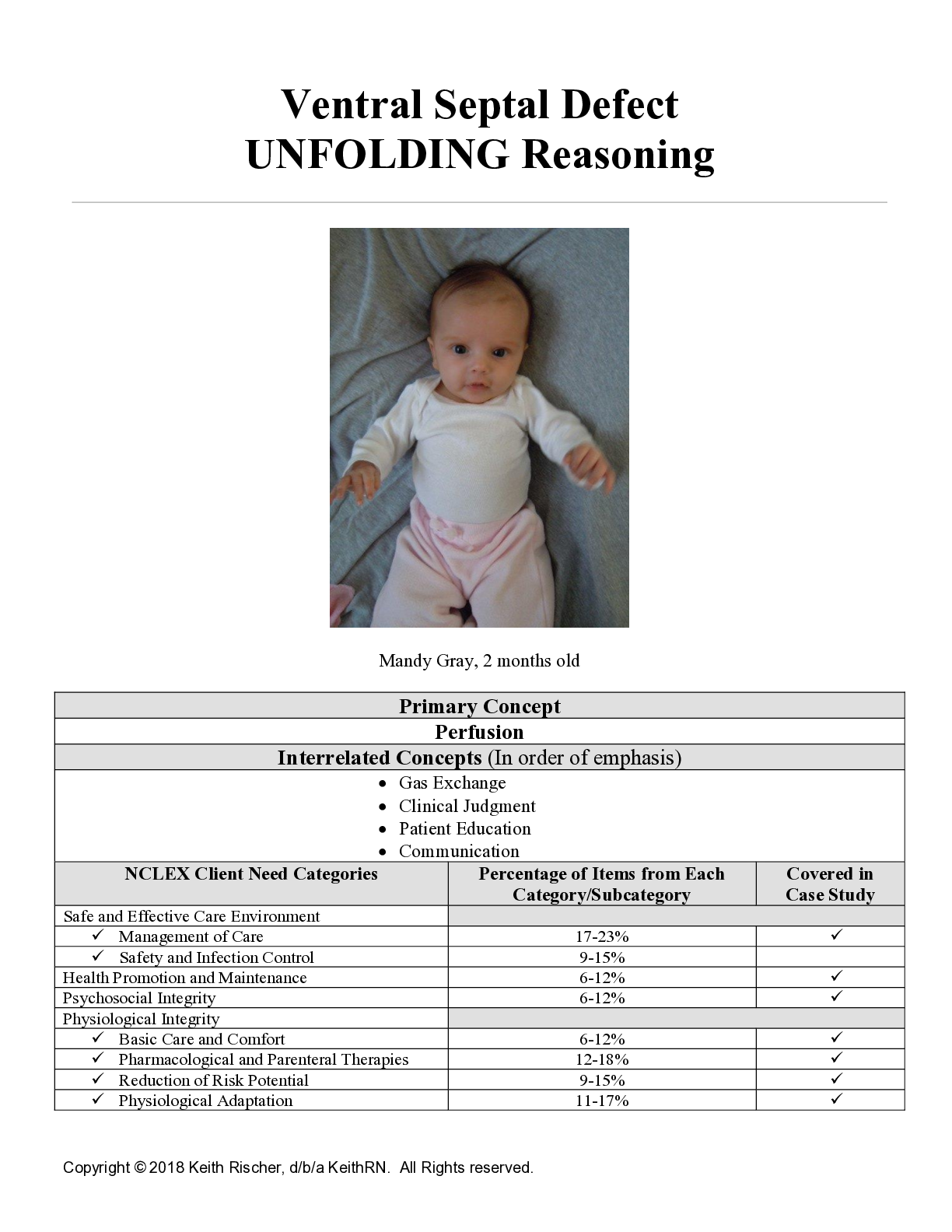
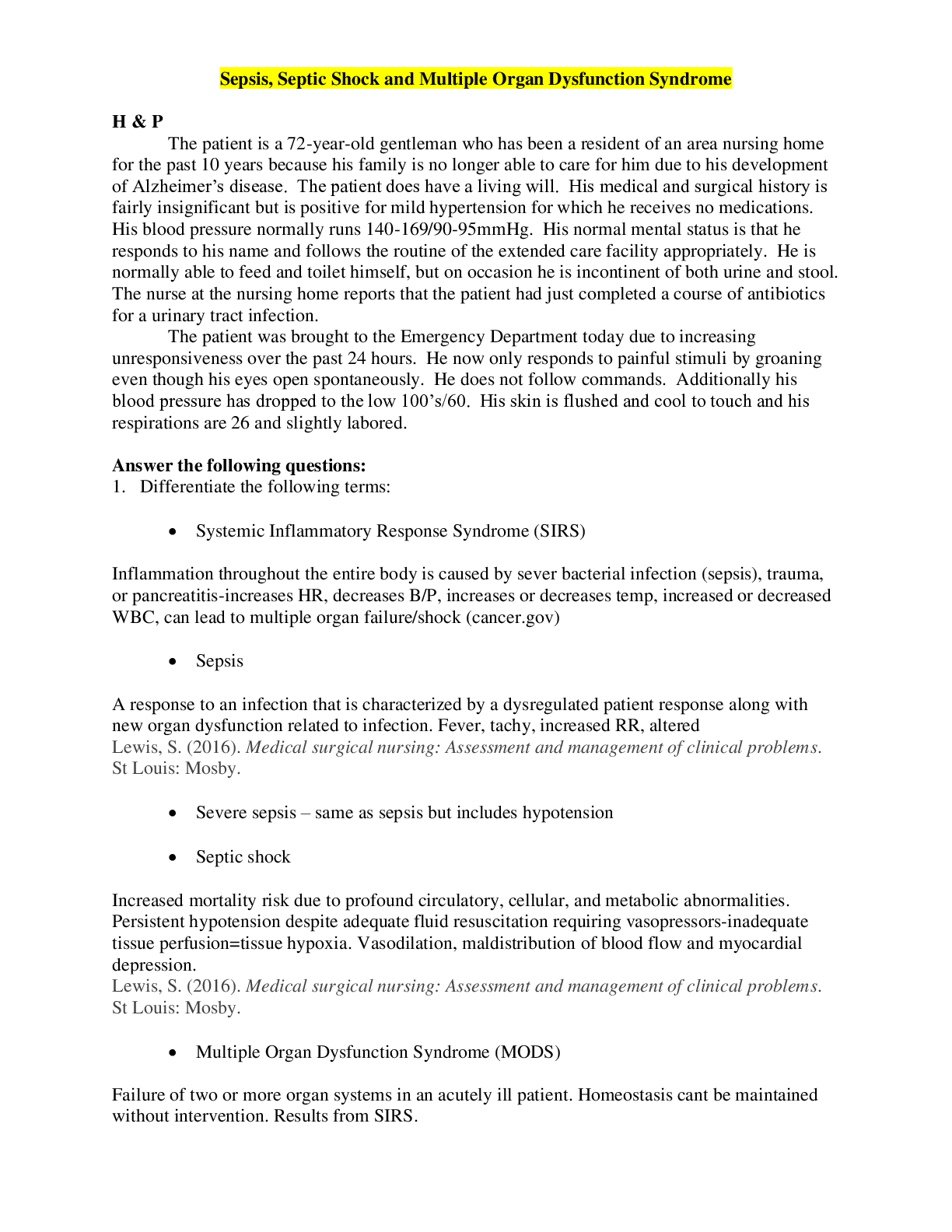
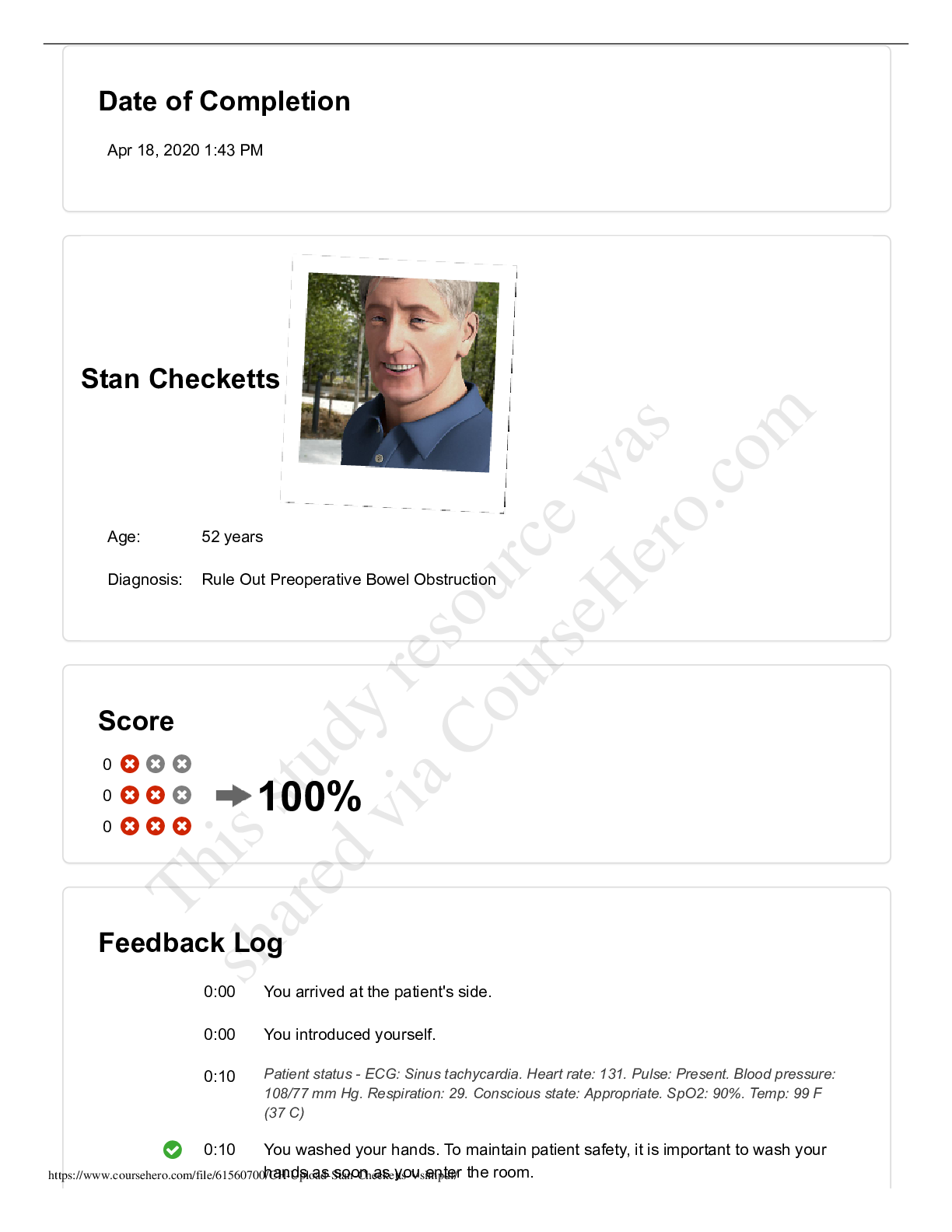

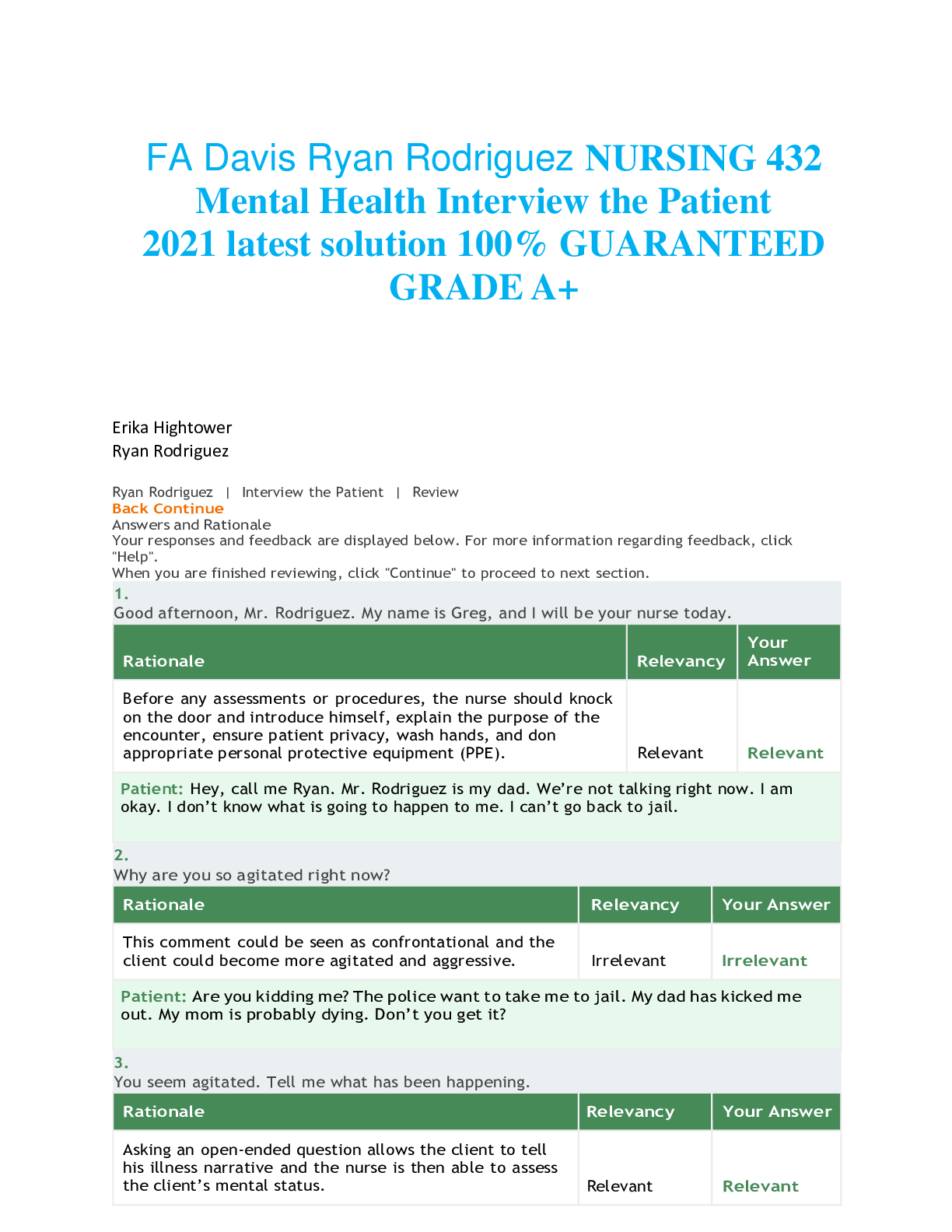
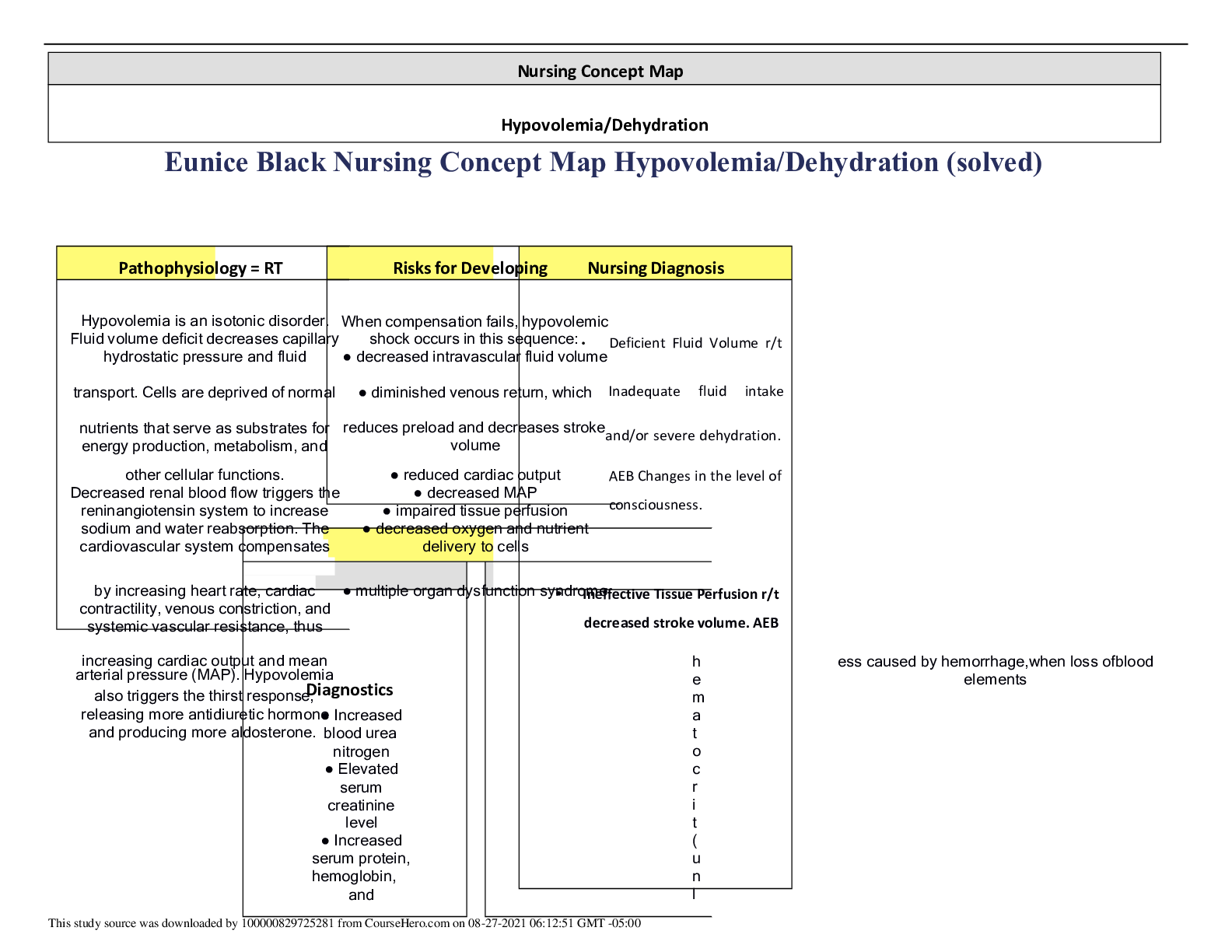
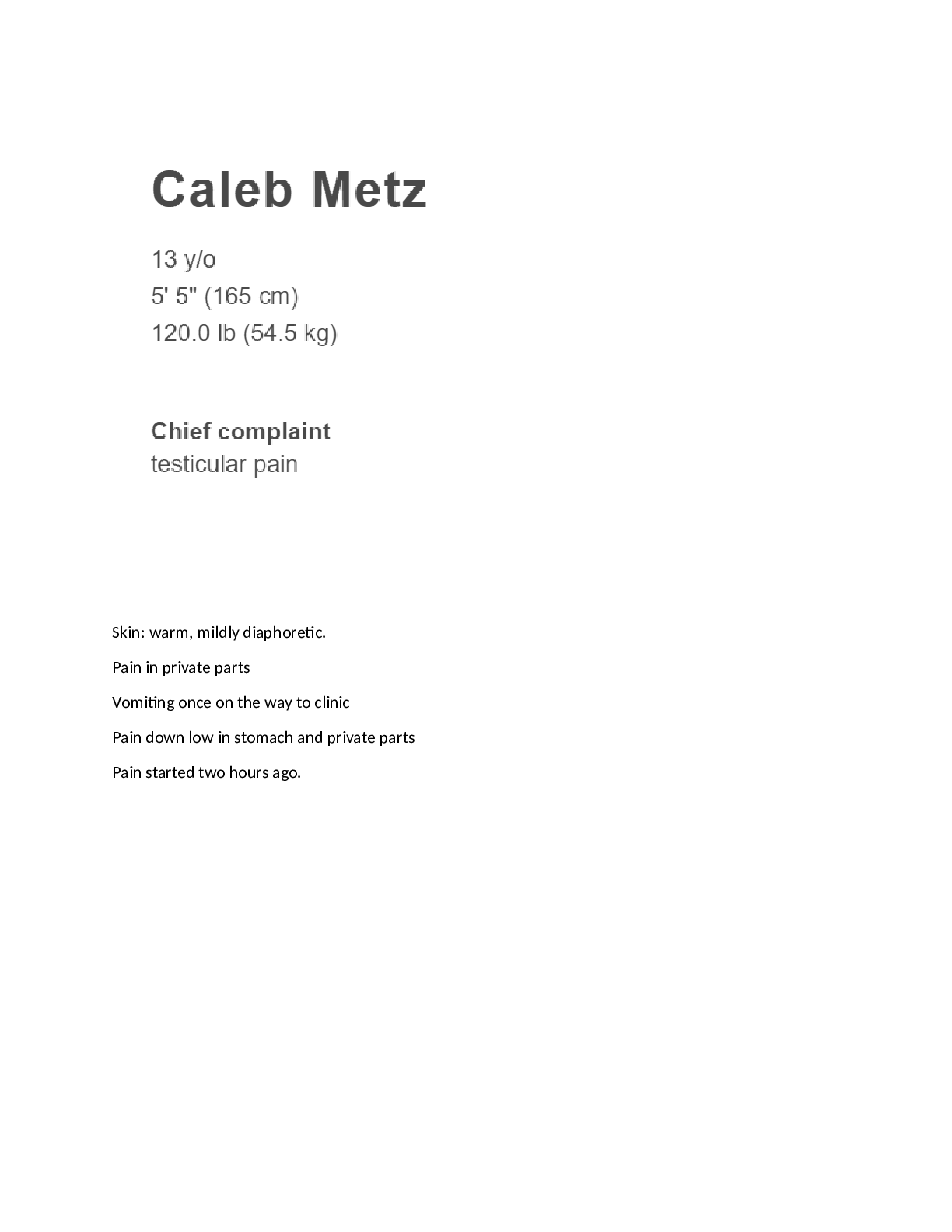




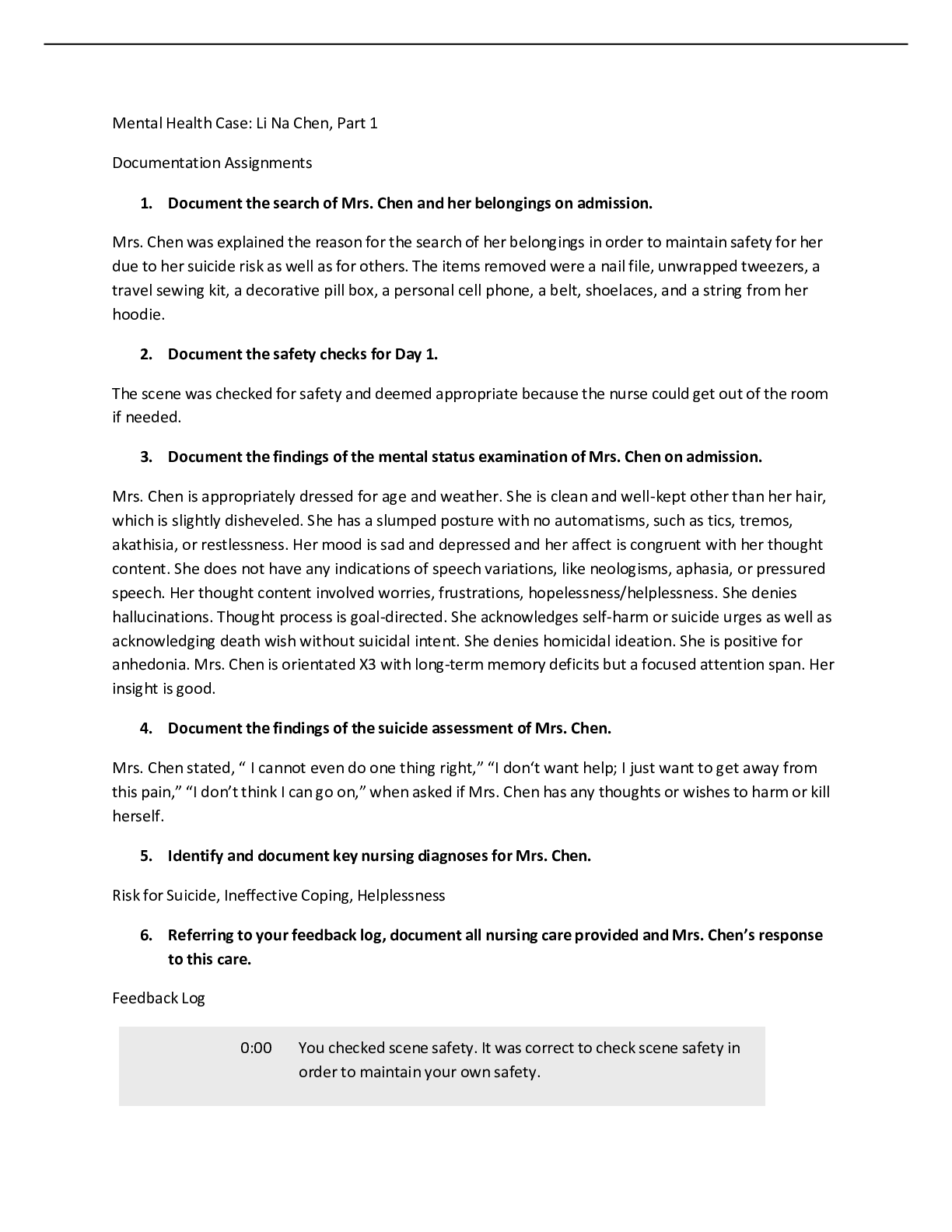
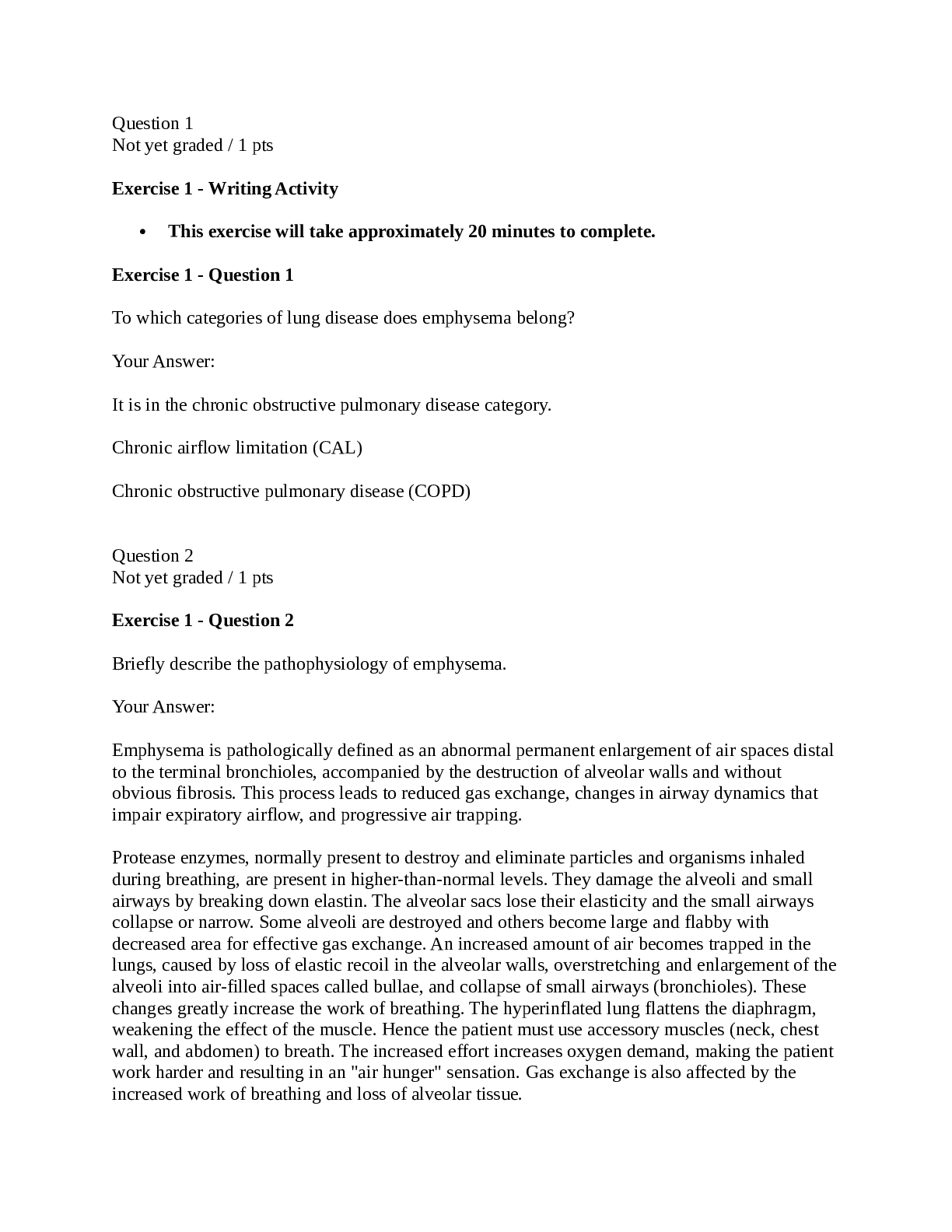


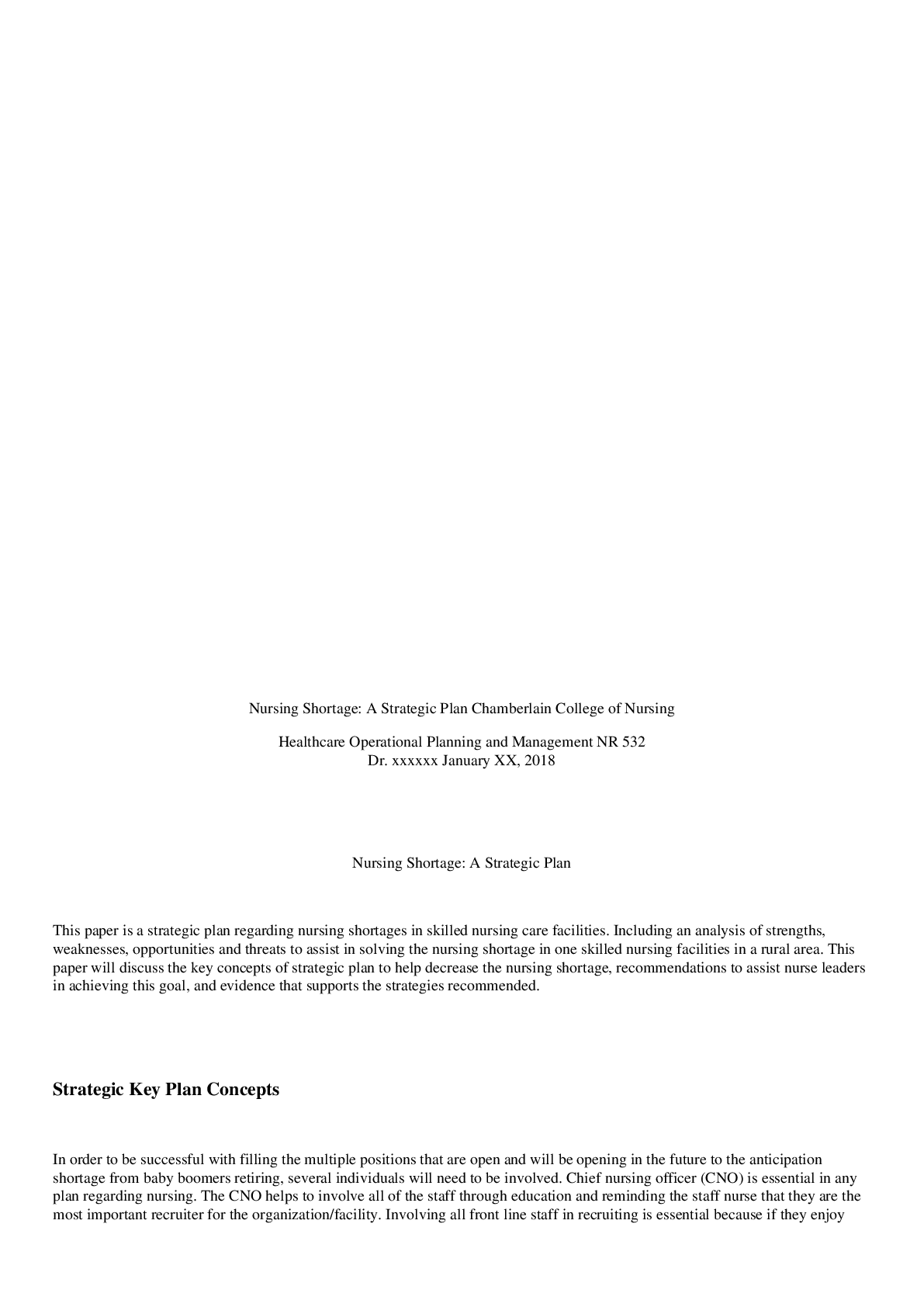
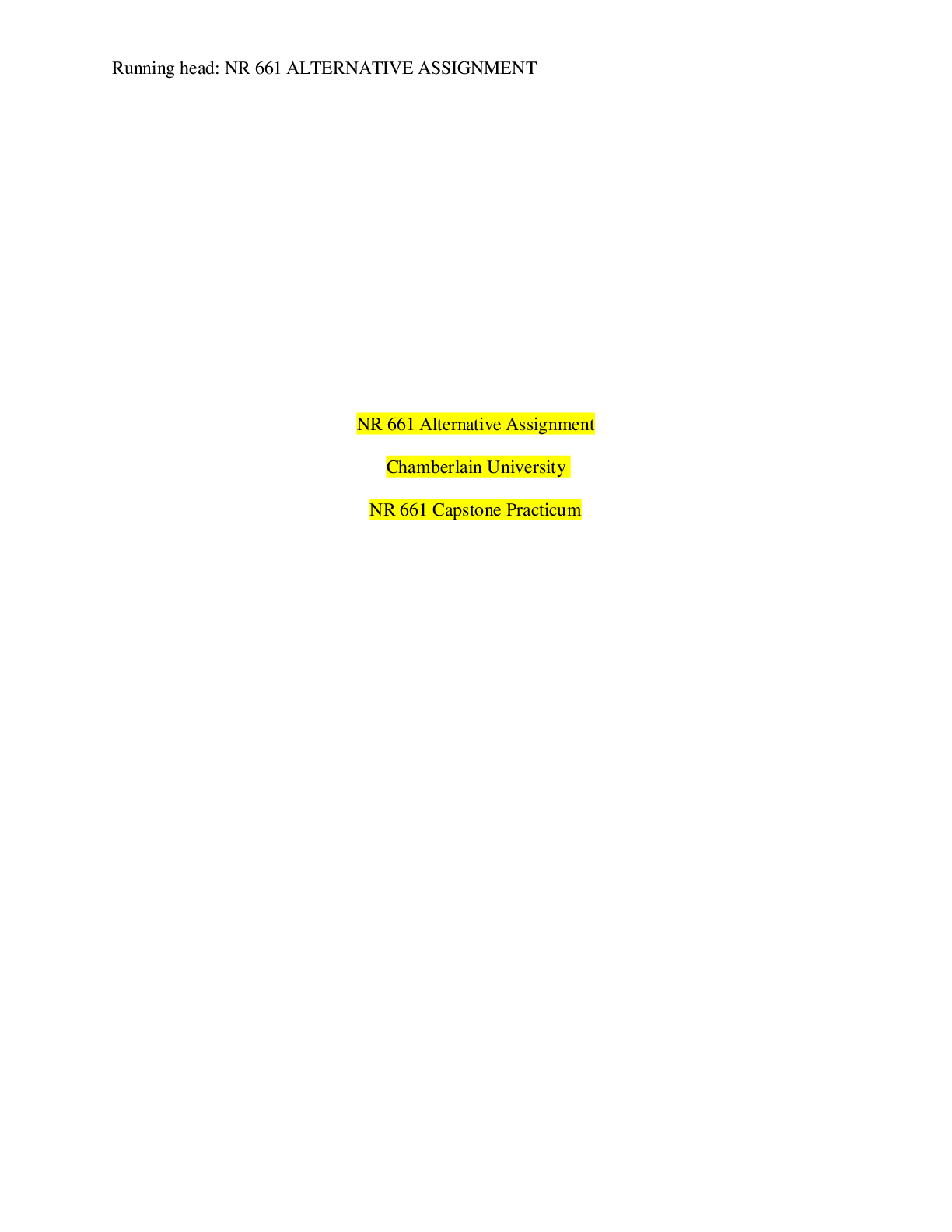
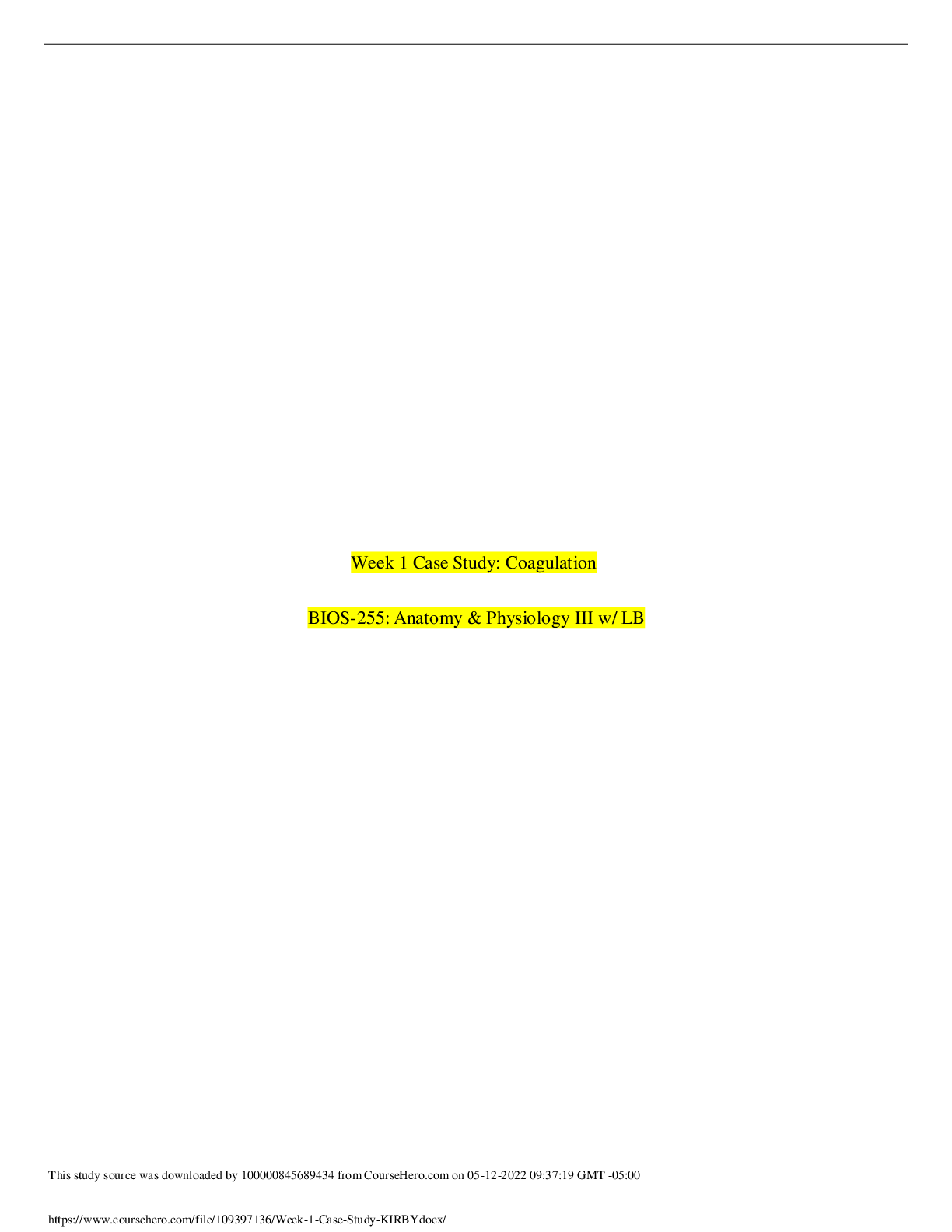
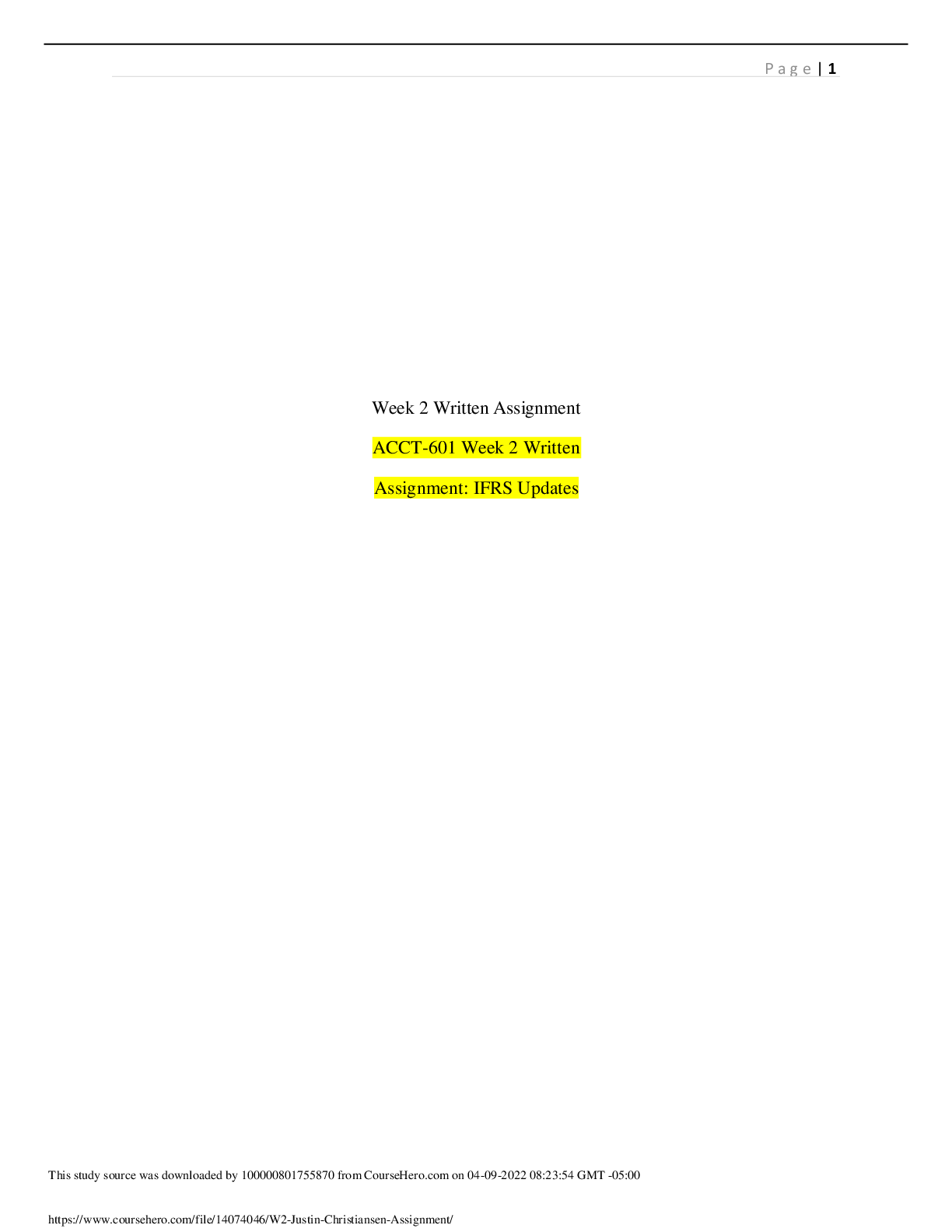
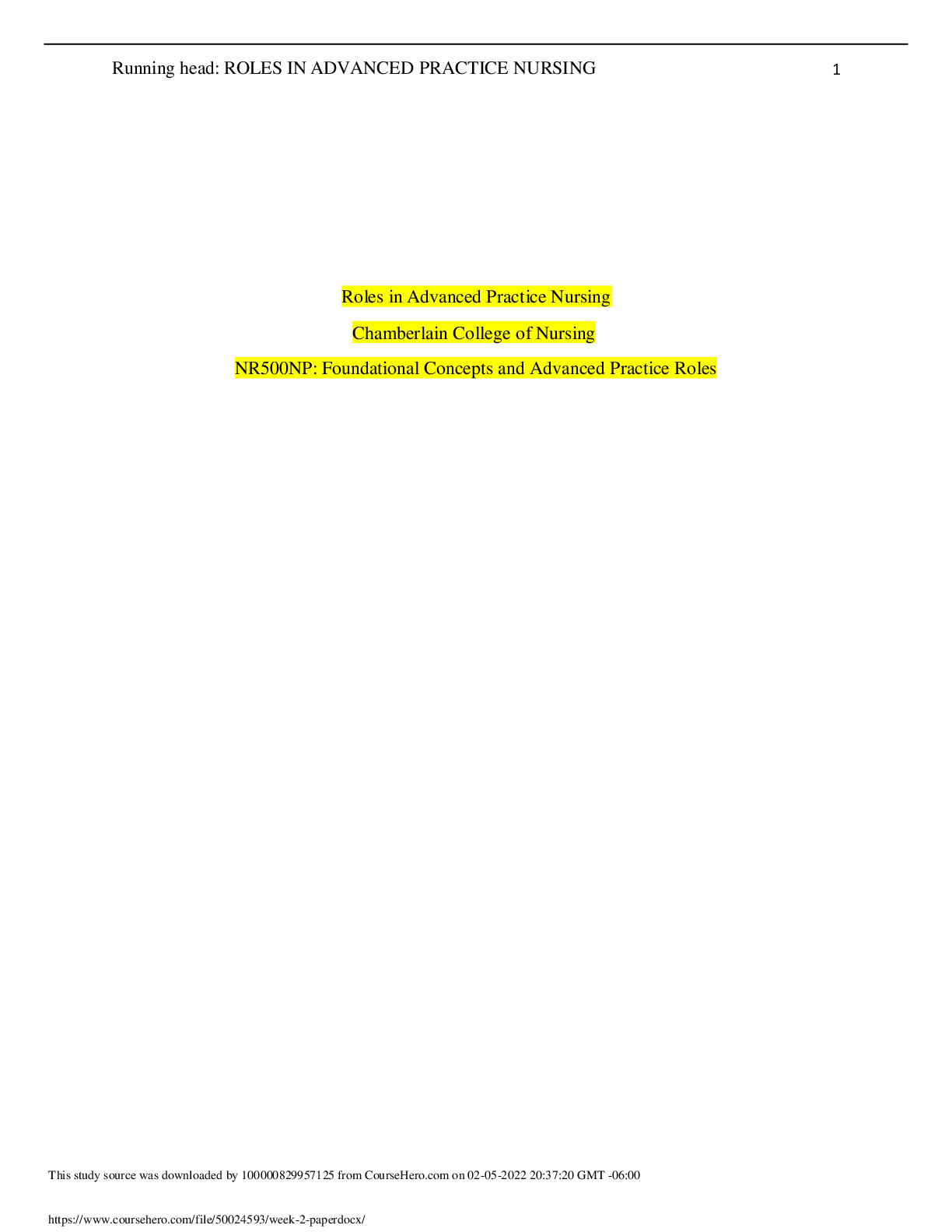
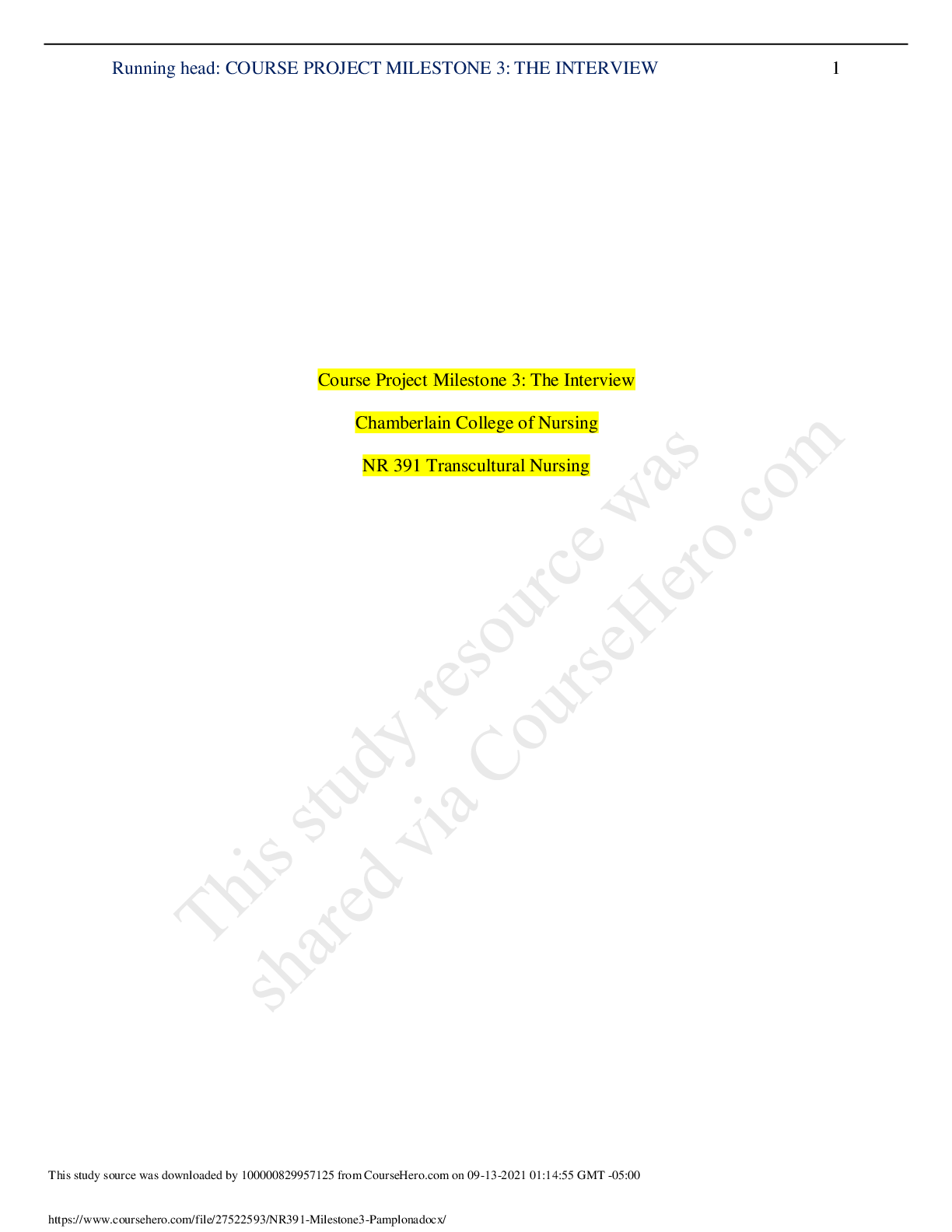

.png)



